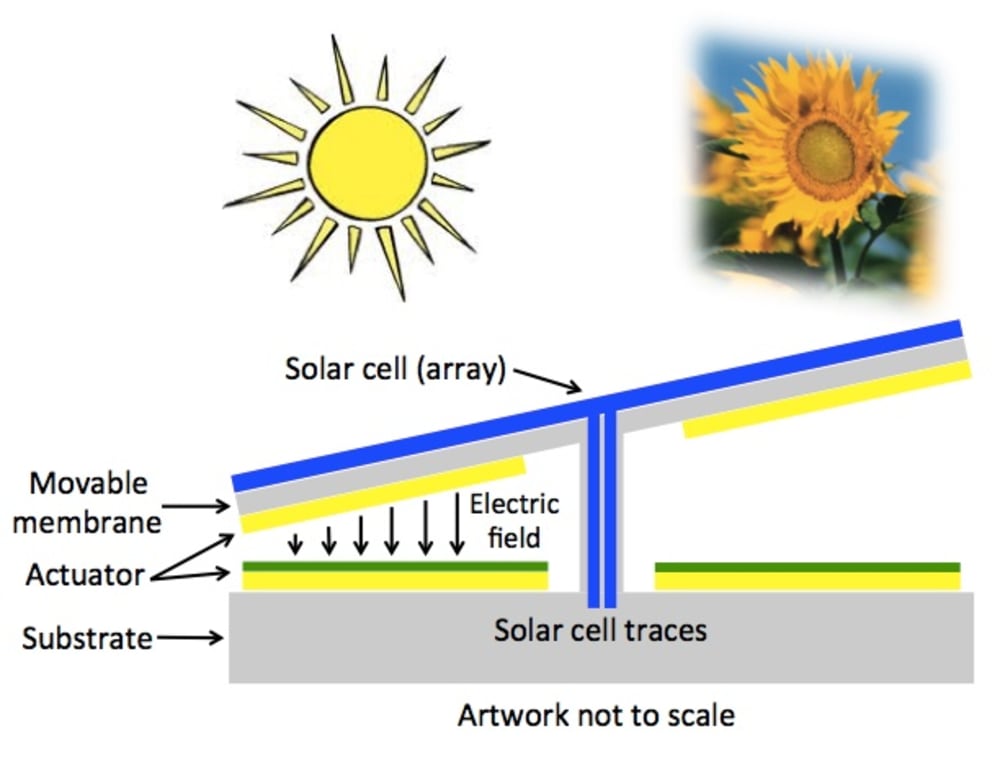This project aims at increasing the conversion efficiency of photovoltaic modules applying the concept of moveable mounting panels to the microscale. Thanks to the improvements in micro-fabrication processes, it is now possible to integrate solar cells over movable structures, realizing the first Micro-Electro-Mechanical-Sunflower (MEMSflower).
Nature has elegantly solved with the sunflower the problem of tracking the Sun during the course of the day to get the maximum irradiation. Man, as often happens, has copied this concept integrating solar panels over movable platforms to track the (relative to Earth) movement of the Sun during the day. This is of paramount importance, since the efficiency of any photovoltaic system is reduced by the angle of incidence at which sunlight strikes the surface of the module. As a result, the energy yield of movable systems can be more than 35% higher than fixed systems. However, big mechanical structures are required to move the solar panels. Despite the improved efficiency the drawback is the wasting of a huge amount of energy (quantifiable in kWh) to move the entire structure and limiting the applicability of such a technology.
Here the innovative idea is making a small array of solar cells (with the size of tens of square micrometers) movable and able to track the Sun, see Fig. 1. The realization of movable micro-membranes has been demonstrated in successful market products (like the Texas Instruments DLP, integrating millions of micro-mirrors).
With a proper design of the actuator structure, movable membrane size and layers thickness, materials and actuator technology choice (electrostatic, piezoelectric, magnetic, etc.), rotations of tens of degrees were demonstrated. Building a solar cell on the top of such a movable structure will lead to the fabrication of a fixed solar panel constituted by millions of movable micro-solar-cells exploiting the advantages of movable panels (increased efficiency), but without drawbacks, as extra power consumption, cells shadowing, reliability, wind problems, design limits, etc.
Both electrostatic and piezoelectric based actuation schemes have been considered and, according to Finite Element Method simulations (done in COMSOL Multiphysics) and measurement of preliminary test-structures, the power required to move the micro-solar-cell unit has been quantified in less than 1 nW, lowering the overall power required to move a complete MEMSflower solar panel to less than 1 mW (100,000 - 1,000,000 time lower than a conventional movable system). A simple algorithm based on astronomical data will then allow to a basic microcontroller to precisely control the micro-movable solar cells to track the Sun based on the time, date, and geographical location of the photovoltaic installation.
Interestingly, the MEMSflower movable micro platform is open to the integration of solar cells based on different technologies, like conventional Silicon, but also organic cells, or, thinking to Space applications, Compound Semiconductors, making possible to improve the solar energy efficiency conversion in different markets. The funding of this project will allow the fabrication of technology demonstrators using traditional MEMS fabrication facilities (as University and Research centers clean rooms) and the successive opening to batch mass production.
Like this entry?
-
About the Entrant
- Name:Augusto Tazzoli
- Type of entry:individual
- Software used for this entry:COMSOL, Office
- Patent status:none

